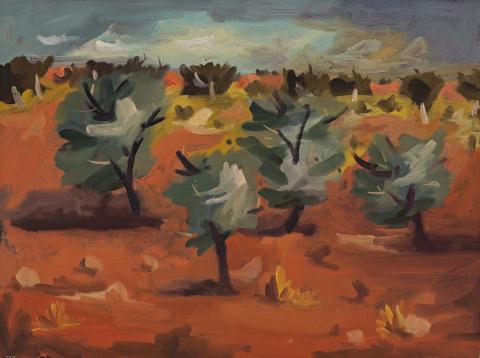SUNDOWN NEAR WARRAWAGINE, c.1960 – 64
SAM FULLBROOK
oil on canvas
52.5 x 70.0 cm
signed lower left: Fullbrook
Clune Galleries, Sydney (inscribed verso)
Lister Gallery, Perth (label attached verso)
Wesfarmers Art Collection, Perth, acquired from the above in 1987 (label attached verso)
Deutscher and Hackett, Melbourne, 29 August 2012, lot 14
Private collection, Sydney
The Song of the Lamb: The Wesfarmers Collection of Australian Art, Art Gallery of Western Australia, Perth, 19 August – 2 October 1989
Gooding, J., Topliss, H., Sharkey, C., and Horridge, N., The Song of the Lamb: The Wesfarmers Collection of Australian Art, Art Gallery of Western Australia, Perth, 1989, p. 90 (illus.)
From timber cutter to commando, Melbourne's National Gallery School to cane cutting in north Queensland, painter of fences, portraits, flowers and landscapes, gold prospector, shearer, lover of horses, racing and punting – Sam Fullbrook was all of them and more. And they all found their way into his art. Diversity was the keynote of his life and his art. His portraits ranged from jockeys, Jockey, Norman Stephens (The Brisbane Club Collection), which won the 1974 Archibald Prize, to the Governor-General. Democratic in his approach, Fullbrook once said that he aimed to 'paint good pictures that children will love'.1 It is no paradox that their lyrical beauty and simplicity of directness were gauged to appeal to the naive and sophisticate alike; but, as in a child's vision, his paintings have a freshness and innocence that evokes the elemental. To this is added his bushman's vision and empathy with the country and its fauna. His compassionate paintings of Aboriginal people drew upon the time spent living and working in an Aboriginal co-operative in north-western Australia. This understanding of the people and their identity with the land is strongly felt in Jacob Obajui, 1956 – 60 (National Gallery of Australia, Canberra), a portrait of the head stockman and elder of the Pindara co-operative. Fullbrook's own time as head stockman in the Pilbara increased even further his identification with the environment. Underneath a toughness of character and appearance lay a deep feeling for the land and its creatures, finding expression in such distinctive paintings as Sundown near Warrawagine, c.1960 – 64 and the evocative 1963 Wynne Prize winner Sandhills on the Darling (collection of the Art Gallery of New South Wales, Sydney).2 Few paintings could be more endearing and humorous than those of native animals – koalas, kangaroos, platypus – even fish. In Aeroplane and Emu, 1964 (private collection), one of his finest works, movement is a metaphor of freedom. Sundown near Warrawagine is informed by a different sense of movement engendered through the lively strokes of his brush. The landscape of Shay Gap pass in the East Pilbara is one of the oldest on earth, of majestic ranges, gorges and deserts. The Warrawagine cattle station nearby joins the Great Sandy Desert to the east. Fullbrook chose the less spectacular, exploring the poetry of the subject in the silence of a timeless land. The softening effects of sunset, or more colloquially 'sundown', are employed to increase that sense of intimacy and harmony so readily felt at the closing of the day. Of art and life, Fullbrook said, 'put your heart and soul into it. Do that and people will love you for it.'3
1. The artist quoted in Horton, M. (ed.), Present Day Art in Australia, Ure Smith, Sydney, 1969, p. 74
2. He also won the 1964 Wynne Prize (shared with David Strachan) with Trees in a Landscape.
3. The artist quoted in Beeby, R., 'You Don't Sell, You Don't Eat', Age, Melbourne, 12 August 1985, p. 11
DAVID THOMAS
